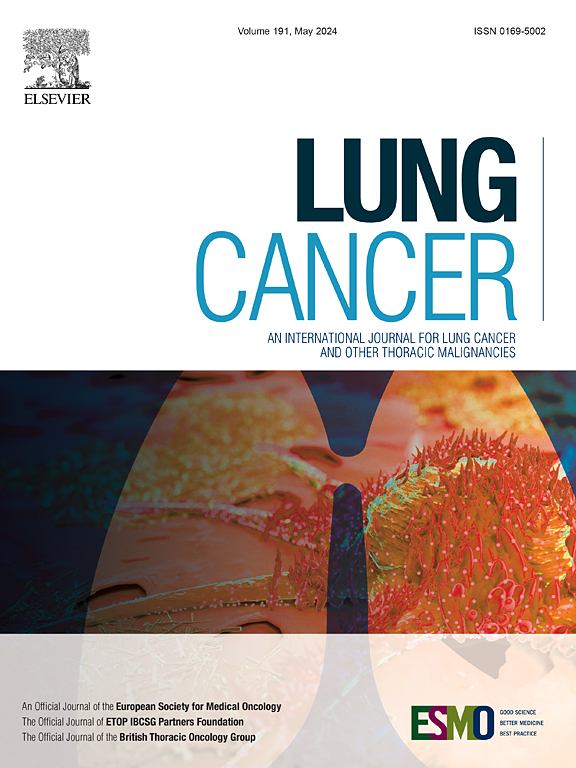Antibody-drug conjugate components in association with the incidence of ADC-related interstitial lung disease: A systematic review and meta‐analysis
IF 4.5
2区 医学
Q1 ONCOLOGY
引用次数: 0
Abstract
Background
Antibody-drug conjugates (ADCs) have emerged as an innovative approach in cancer therapy. Although the incidence of ADC-related interstitial lung disease (ILD) is low, it remains a clinically significant and potentially fatal adverse event. This study focuses on evaluating the incidence of ADC-related ILD and examining how specific ADC components contribute to the risk of ILD.
Methods
Five databases were conducted to identify clinical studies on ADC-related ILD published up to September 2024. The incidence of treatment-related adverse events was calculated by a random effects (RE) model.
Results
A total of 120 clinical studies involving 20,119 patients were included. The overall incidence of ADC-related ILD was 4.40 % (1215/20119) for all-grade and 2.35 % (603/20119) for grade ≥ 3 ILD. Among these, 2287 patients had hematologic tumors and 17,832 patients had solid tumors. Particularly, gastrointestinal cancers (12.81 %, 107/835), followed by lung cancer (9.70 %, 290/2991) were observed with a high incidence of ILD. A detailed subgroup analysis was performed, stratified by payload, drug-to-antibody ratio (DAR) value, linker type, and target. ADCs with cleavable linkers exhibited a higher incidence, notably, ADCs with glutathione (GSH) linkers were the highest. Furthermore, ADCs with high DAR had a higher incidence of ILD. Interestingly, payload type alone did not significantly affect the incidence, while a marked increase in ILD risk was observed when specific payloads (such as topoisomerase I inhibitors) were combined with high DAR values or cleavable linkers.
Conclusion
This study reveals variability of ADC-related ILD incidence, largely driven by the specific components of the ADCs, offer valuable insights into potential ILD occurrence patterns and guide for optimizing ADC design.
抗体-药物偶联成分与adc相关间质性肺疾病发病率相关:一项系统综述和荟萃分析
抗体-药物偶联物(adc)已成为癌症治疗的一种创新方法。虽然adc相关间质性肺疾病(ILD)的发生率很低,但它仍然是一个具有临床意义的潜在致命不良事件。本研究的重点是评估ADC相关ILD的发生率,并检查特定ADC成分如何导致ILD的风险。方法对截至2024年9月发表的adc相关ILD临床研究进行数据库检索。通过随机效应(RE)模型计算治疗相关不良事件的发生率。结果共纳入120项临床研究,涉及20119例患者。adc相关ILD的总发生率为4.40%(1215/20119),≥3级ILD的总发生率为2.35%(603/20119)。其中血液学肿瘤2287例,实体瘤17832例。尤其是胃肠道肿瘤(12.81%,107/835),其次是肺癌(9.70%,290/2991),其发生率较高。进行了详细的亚组分析,根据有效载荷、药抗体比(DAR)值、连接物类型和靶标进行分层。可切割连接的adc发生率较高,其中谷胱甘肽(GSH)连接的adc发生率最高。此外,具有高DAR的adc具有更高的ILD发生率。有趣的是,单独的有效载荷类型对发病率没有显著影响,而当特定的有效载荷(如拓扑异构酶I抑制剂)与高DAR值或可切割连接物结合时,ILD风险显着增加。结论本研究揭示了ADC相关ILD发病率的变异性,主要由ADC的特定成分驱动,为潜在的ILD发生模式提供了有价值的见解,并为优化ADC设计提供了指导。
本文章由计算机程序翻译,如有差异,请以英文原文为准。
求助全文
约1分钟内获得全文
求助全文
来源期刊

Lung Cancer
医学-呼吸系统
CiteScore
9.40
自引率
3.80%
发文量
407
审稿时长
25 days
期刊介绍:
Lung Cancer is an international publication covering the clinical, translational and basic science of malignancies of the lung and chest region.Original research articles, early reports, review articles, editorials and correspondence covering the prevention, epidemiology and etiology, basic biology, pathology, clinical assessment, surgery, chemotherapy, radiotherapy, combined treatment modalities, other treatment modalities and outcomes of lung cancer are welcome.
 求助内容:
求助内容: 应助结果提醒方式:
应助结果提醒方式:


